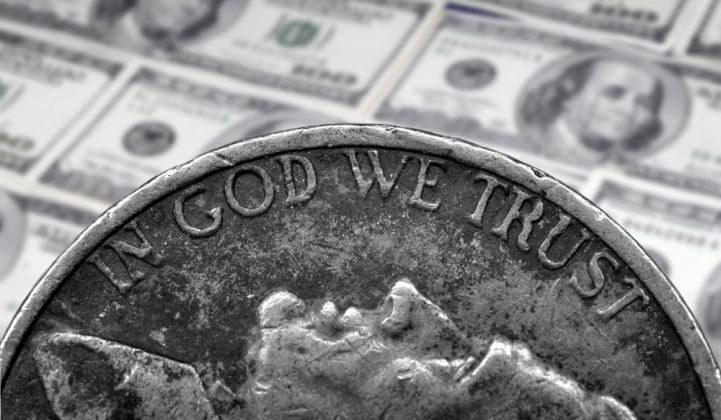Representatives from JPMorgan Capital, Goldman Sachs and Bank of America Merrill Lynch who spoke at this week's Cost of Capital event agreed that tax equity and bank debt should continue to provide the backing that renewables need this year.
John Eber, who leads JPMorgan's capital energy investments team, expects “a sizeable pipeline of opportunities in both solar and wind tax equity in 2014.”
Wind yields have been stable at 7.5 percent to 8.5 percent after tax on unleveraged transactions, said Union Bank VP Lance Markowitz. Solar yields have been more diverse.
“Utility-scale solar is probably the most aggressively bid and may be a little lower. Rooftop solar may be a little higher and have a wider range," said Markowitz.
Project finance through bank debt was up about 20 percent in 2013 to approximately $29 billion; however, most of the growth was in oil, gas and conventional power, while renewables were flat or down.
Interest is about 200 basis points over the LIBOR rate, said Richard Randall, executive director of Industry Funds Management. And with more banks getting in, downward pressure on interest will continue.
For a ten-year deal, the approximately 3.25 percent LIBOR rate goes up as much as 0.25 percent every three to four years, said Thomas Emmons of Rabobank. Upfront fees are in the low 2 percent range. For institutions, the LIBOR floor is around 1 percent, Randall added, and bank loans span seven to ten years.
Renewables projects' “pretty narrow risk” is adding liquidity, said Bank of America Merrill Lynch Head of U.S. Power & Renewables Raymond Wood. “The trend is our friend.”
Combined financing is common in renewables, Emmons said. “The larger transactions are being done mostly as club deals.”
Institutions are coming in because even if the primary form of takeout proves problematic, there are many secondary takeouts, Wood said. It saves the sponsor money to bring in other investors and reduce the underwriting risk.
Hedged wind deals have increased in the last twelve to eighteen months, primarily in the PJM and ERCOT markets, noted Goldman Sachs Co-Head of U.S. Capital Markets Raya Prabhu. And that trend will continue, driven by the cost of natural gas and expected coal plant retirements.
Term loan B debt, a type of bank debt sold to a commercial bank, an institutional investor, or a high-yield investor, is especially attractive in a rising interest rate environment, explained James Finch, co-head of capital markets at Credit Suisse USA. In 2013, B loan issuance money came into the markets at the rate of about $750 million to $1 billion per week as investors, looking for new places to put their money because of a lack of mergers and acquisitions, recognized the above-market returns and reduced risk in project financing.
About $2 billion to $3 billion went to green field power projects financed in the term loan B market in 2013, Prabhu estimated.
There have been very few project bond market deals, but it is “wide open,” Wood said, predicting more activity in high-yield and investment-grade bonds.
Among the biggest challenges for solar, Eber said, is the coming revaluation of the investment tax credit. Having a consistent and transparent regulatory environment would help get a lot of deals over the finish line, Prabhu agreed. In solar DG, Emmons said, the mechanics of portfolio financing need to be clarified.
Institutional investors are at or near all-time margin lows, Randall said, so the challenge is finding deals that fit and provide good yields.
Factors such as rising interest rates, compression of margins and the varying quality of transactions make for a challenging renewables investment environment, Finch said. Transaction quality is the big issue, Markowitz agreed. “Some are easy to get completed, but some developers are pushing the envelope.”
Resolving the complications blocking YieldCos is also a big challenge, said Wood. And residential and commercial distributed generation must be supported by banks and Wall Street, “given the quantum of capital that is now being allocated.”



